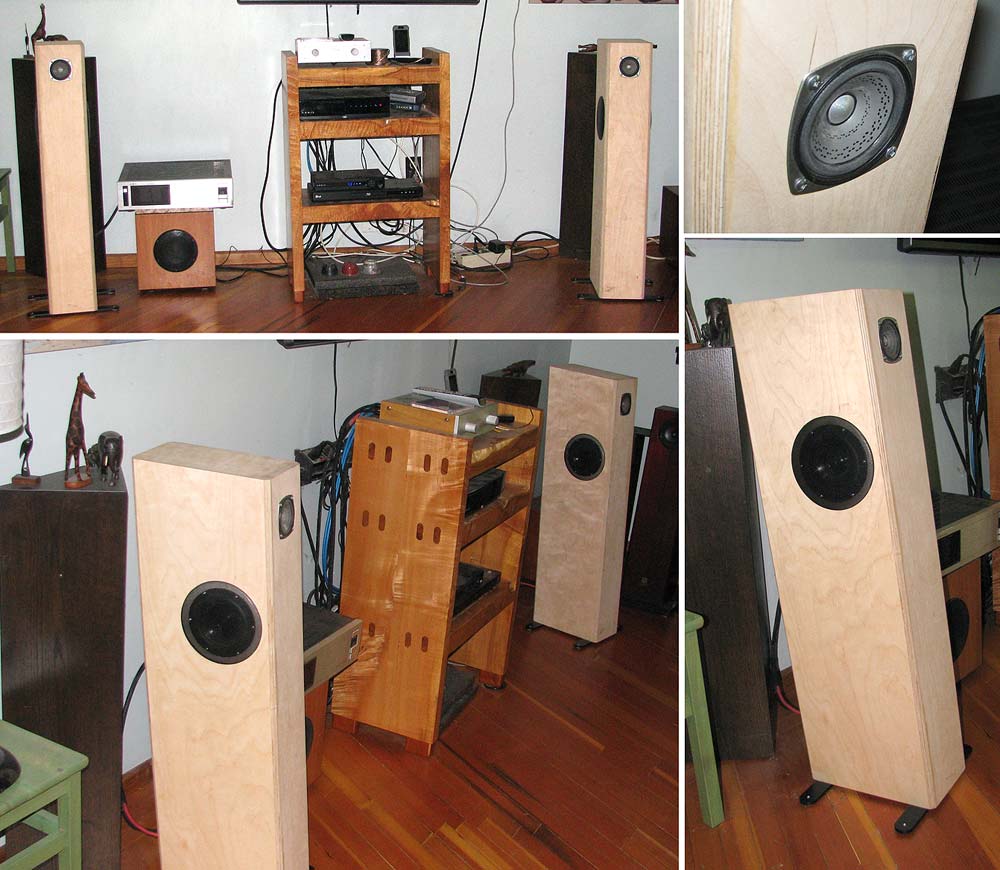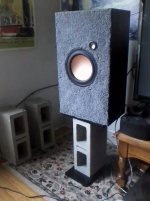To be returned to Dave shortly - I believe he has more time on his hands for listening presently than I.
Member
Joined 2009
Paid Member
A proprt review will have to wait till i put back the music server back in (which Chris took out to make it easier for Ruth to operate when i was in the hospital). So far i have listened to one CD which was very good and lots of TV.
dave
dave
Member
Joined 2009
Paid Member
A proprt review will have to wait till i put back the music server back in (which Chris took out to make it easier for Ruth to operate when i was in the hospital). So far i have listened to one CD which was very good and lots of TV.
dave
I'm glad you're back in action - you still manage to get more done than me 😱
you still manage to get more done than me
Its really me & Chris (& Bernie to a lesser extent). Aaron designed the passive XO in these. I couldn’t do it by myself.
dave
I have to say I'm impressed with some of the fast systems on here. I recently built a system using an aurasound whisper and hi-vi m8n.
What baffles me (no pun intended) is if you listen through a PC like I do, then why more people don't use the PC as the crossover? I use a simple program called equalizer apo and then duplicate the channels coming from the soundcard. So I have 2 identical left and 2 identical right channels. Then I use the equalizers to craft the FR of each driver. I cut off the bottom for the tweeters and cut off the HF for the woofers. I even overlap them at certain points.
This is all done in the digital domain, completely free of distortion and phase shift. I then send the signals to the amps. Pretty easy, perfect control. Only downside is that you can't use your speakers without a PC. You can also use this software to perfectly equalize out the response of the drivers.
What baffles me (no pun intended) is if you listen through a PC like I do, then why more people don't use the PC as the crossover? I use a simple program called equalizer apo and then duplicate the channels coming from the soundcard. So I have 2 identical left and 2 identical right channels. Then I use the equalizers to craft the FR of each driver. I cut off the bottom for the tweeters and cut off the HF for the woofers. I even overlap them at certain points.
This is all done in the digital domain, completely free of distortion and phase shift. I then send the signals to the amps. Pretty easy, perfect control. Only downside is that you can't use your speakers without a PC. You can also use this software to perfectly equalize out the response of the drivers.
Only downside is that you can't use your speakers without a PC.
I have XOs built into the PureMusic sw i use on top of iTunes, but the need to run the TV thru the system makes using it a no go.
dave
This is all done in the digital domain, completely free of distortion and phase shift.
That is not quite true.
Check out the differences between linear phase and minimum phase EQ apps or VSTs out there. Hint: they each have their advantages and flaws.
Also, being able to EQ the frequency response is a good thing that some take way too far trying to "hammer" (as wesayso would say) a driver to follow our ideal frequency response, way out of the driver's comfort range, and introduce a lot of distortion that wasn't there in the first place.
All very simple to see when using a mic and a program like REW.
A more elegant solution would be to use JRiver and its routing of channels, and if you want to get rid of the computer, than a miniDSP unit would be just perfect.
That is not quite true.
Check out the differences between linear phase and minimum phase EQ apps or VSTs out there. Hint: they each have their advantages and flaws.
Also, being able to EQ the frequency response is a good thing that some take way too far trying to "hammer" (as wesayso would say) a driver to follow our ideal frequency response, way out of the driver's comfort range, and introduce a lot of distortion that wasn't there in the first place.
All very simple to see when using a mic and a program like REW.
A more elegant solution would be to use JRiver and its routing of channels, and if you want to get rid of the computer, than a miniDSP unit would be just perfect.
Hi, Maybe when I said it takes place digitally was a bit confusing. I can't say I'm the person who wrote Equalizer apo software, but I believe that the way it works is that it takes control of the soundcard itself so that the changes to the signal (like removing everything above 2000hz on a woofer channel) are done computationally before the signal is even generated.
Each driver has its own channel when the signals leave the soundcard and then go to amplifiers (I use a couple old HT receivers). I use 4 channels total for a right and left 2 way. But 6 channels for a 3 way possible to.
This is actually preferable to "digital" equalizers or anything else that carves up the signal after its been generated. I haven't used mini-dsp, and since this software is free I see no reason to. If someone were to take this idea and make it into a firmware device (so I don't need a PC) that would be nice, and maybe mini-dsp does that.
Its also great for equalizing out the raggedness of full range drivers.
BTW, I agree that you can't make a driver do something too demanding without creating distortion. As rule I try not to add more that 6db gain anywhere. However you can always reduce gain which is essentially what a crossover is, a gain control device
maybe spend an afternoon or two researching at the minidsp site - they've covered a lot of bases.
Home | miniDSP
Home | miniDSP
maybe spend an afternoon or two researching at the minidsp site - they've covered a lot of bases.
Home | miniDSP
Yes I did look into this some more. I can't confirm exactly how equalizer apo changes tone and frequency. As best as I can tell the equalizer part is a linear phase equalizer. It also has other filters like low and high pass filters.
Linear phase is better, but any equalization can add artifacts to the signal (ringing for example, but if and when this is audible is not an easy answer. If you listen to any modern music its probably been passed through many PC filters and equalizers already.
Mini dsp doesn't at this point offer the equalization control that equalizer apo does but it does have other advantages like being programmable separate from the PC.
Bottom line in using a fast system or even complex active systems either solution would offer better control and probably less distortion than a typical crossover.
Attachments
Tysen using RS 40-1354
Stumbled on a small stash of RS 40-1354 so I decided to give the Tysen a try using what I had on hand. Since I'd already built the mini Onken from Planet 10 using the Fostex ff85wk I left off the top section from the plans. I was limited to 30" tall because that's the size sheets the local supplier had. Currently using a simple 1st order XO and bi-amping. So far I'm liking them. Thanks to David Dlugos for all the help and great plans.
Stumbled on a small stash of RS 40-1354 so I decided to give the Tysen a try using what I had on hand. Since I'd already built the mini Onken from Planet 10 using the Fostex ff85wk I left off the top section from the plans. I was limited to 30" tall because that's the size sheets the local supplier had. Currently using a simple 1st order XO and bi-amping. So far I'm liking them. Thanks to David Dlugos for all the help and great plans.
Attachments
Made some progress on my project using RS 40-1354 in a Tysen. After listening and inquiries, I determined that 2 of the 1354 in one box was too much unlike the recommended driver Silver Flute W14. Not wanting to give up on my project, I patched the extra hole and tried again. So far I'm pleased with the result. One thing that most impresses me is the clarity of bass lines. I de-whizzered, phase plugged, and Mod Podged my 1354's. While they don't go super low, I'm pleased with the amount of bass I'm hearing. I'm bi-amping, using SS for LF and tubes for HF. I just wish I could figure out a way to bi-amp and using my turntable. Thanks to David Dlugos for a great concept and assistance along the way.
- Home
- Loudspeakers
- Full Range
- A thread for Tysen and variations on WAW / FAST


![IMG_0722[1].jpg](/community/data/attachments/804/804192-d0465a18d1e481b10080b6008ffc2496.jpg?hash=0EZaGNHkgb)
![IMG_0743[1].jpg](/community/data/attachments/830/830076-8f87cf3d00eb838b65001f4b72d1b38e.jpg?hash=j4fPPQDrg4)
![IMG_0744[1].jpg](/community/data/attachments/830/830100-ec1eb2ed86836868498a3f28f1b4d793.jpg?hash=7B6y7YaDaG)